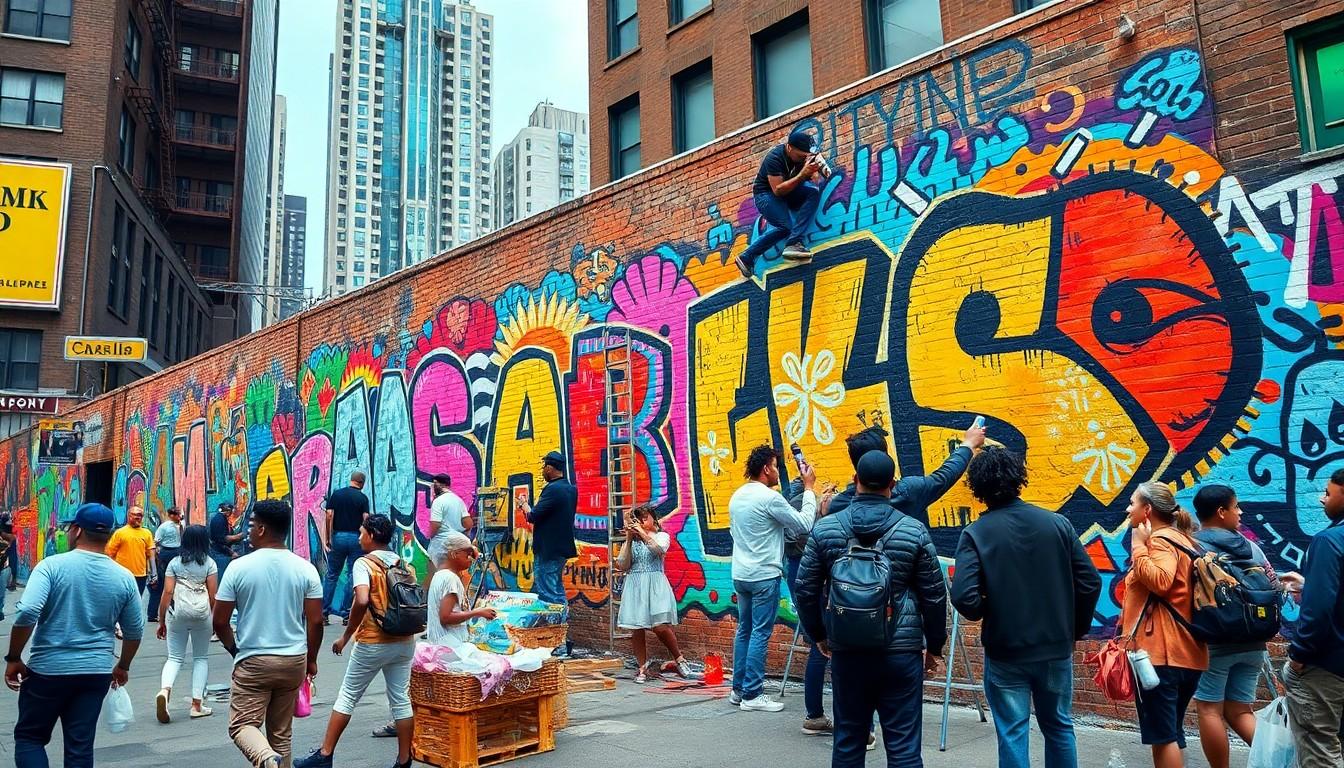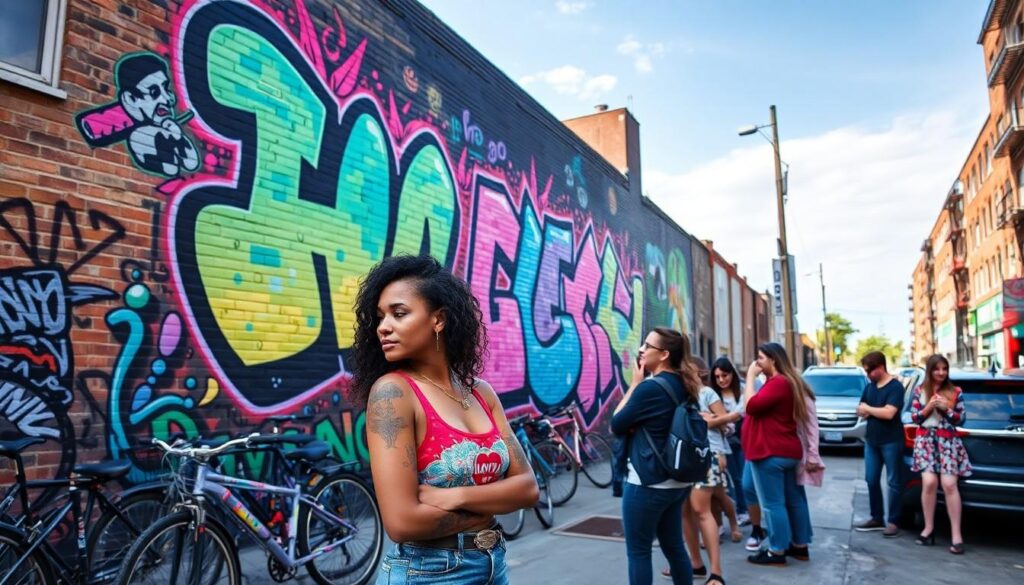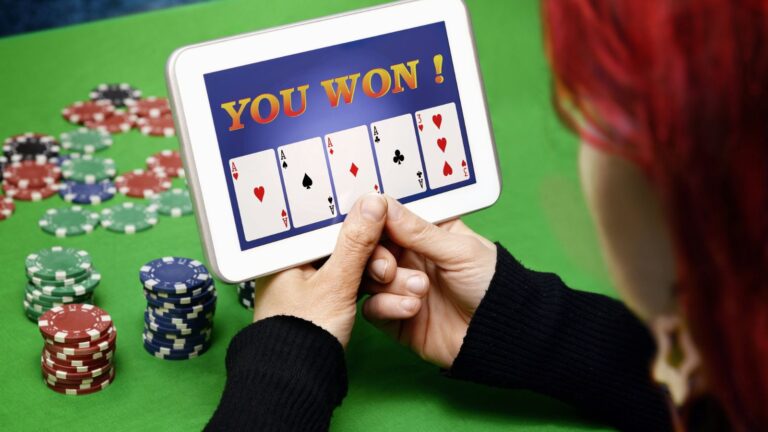New York City’s streets are like a vibrant canvas, bursting with creativity and culture. From the moment you step outside, you’re greeted by a kaleidoscope of colors and styles that tell stories without uttering a single word. Street art isn’t just decoration; it’s a movement that transforms mundane sidewalks into galleries that rival the most prestigious museums.
Table of Contents
ToggleOverview of NYC Street Art
NYC street art embodies a dynamic expression of urban culture. Murals, graffiti, and installations transform surfaces into captivating visuals that reflect societal issues and individual voices. Artists utilize public spaces, allowing art to reach a diverse audience.
Locations such as Bushwick in Brooklyn and the Lower East Side in Manhattan showcase iconic pieces that attract tourists and locals alike. Vibrant colors capture attention, while intricate designs invite closer inspection. Creatives from various backgrounds contribute unique styles, enriching the overall landscape.
Contemporary themes often emerge within NYC’s street art scene. Social justice, political commentary, and environmental issues frequently appear in artworks, fostering dialogue and awareness. This art form serves as a platform for marginal voices, turning streets into forums for expression.
Certain artists gain recognition, establishing names within the broader art community. Banksy, Shepard Fairey, and Keith Haring represent just a few influential figures whose work has left a lasting impact on the city’s aesthetic. Their styles inspire a new generation of artists, pushing boundaries and exploring innovative techniques.
Art festivals, like the Bushwick Collective and the New York City Graffiti and Street Art Festival, celebrate this vibrant scene. These events bring artists together, facilitating collaboration and fostering creativity. They highlight the importance of street art in shaping the city’s identity.
Overall, the rich tapestry of NYC street art reflects the spirit of the city. It’s not merely an aesthetic choice but a cultural phenomenon that resonates with the community and beyond. This ever-evolving landscape continues to attract attention, making New York City a pivotal location for street art enthusiasts.
Historical Background

New York City’s street art has deep roots that trace back several decades. Cultural shifts in the 1970s sparked the initial wave of urban graffiti, marking the beginning of a distinct artistic movement.
Evolution of Street Art in NYC
Emerging from the city’s tumultuous socio-economic landscape, street art evolved from simple tagging to elaborate murals. The 1980s introduced artists like Jean-Michel Basquiat and Keith Haring, who elevated graffiti to fine art, showcasing its potential on larger platforms. By the 1990s, street art flourished with the rise of public art initiatives, allowing artists to gain even more visibility. Artists utilized the cityscape to voice dissent and inspire change. Recent years saw a surge in popularity, with street art festivals and guided tours highlighting various works.
Key Movements and Influences
Several movements have shaped the street art scene in NYC. The hip-hop movement of the late 1970s heavily influenced early graffiti, reflecting urban culture and identity. In the 1980s, postmodernism introduced new styles and techniques, broadening creative possibilities. Political art gained momentum during the early 2000s, with artists like Shepard Fairey addressing social justice issues. Today, environmental themes emerge prominently, showcasing a collective consciousness around global challenges. Each movement contributes to the vibrant, ever-evolving tapestry of NYC street art.
Notable Areas for Street Art
New York City boasts several neighborhoods renowned for their vibrant street art. Each area offers unique contributions to the city’s dynamic artistic landscape.
Williamsburg
Williamsburg in Brooklyn stands out as a hub for street art enthusiasts. Artists frequently decorate its walls with bold murals and striking installations. Visitors often discover a mix of contemporary styles and cultural references throughout the area. Famous pieces include large-scale murals by artists like Tristan Eaton and Shepard Fairey. The neighborhood’s creative energy captivates not only locals but also tourists looking to explore NYC’s art scene.
Bushwick
Bushwick serves as an outdoor gallery featuring works by both established and emerging artists. The Bushwick Collective showcases a variety of street art styles and constantly changes throughout the year. Many masterpieces blend vibrant colors with social and political commentary. Murals by artists like Olek and LNY often provoke reflection and dialogue about current issues. Art walks and events in the area attract crowds eager to appreciate these stunning visual narratives.
Lower East Side
The Lower East Side captures the essence of NYC’s street art history. This neighborhood combines gritty aesthetics with a rich cultural heritage. Many walls tell stories of the community, showcasing art that addresses social justice and collective struggles. Artists like Futura and Swoon contribute to the neighborhood’s ongoing legacy of innovative expression. Spaces like the Museum of Street Art further solidify the Lower East Side as a pivotal player in the city’s vibrant street art scene.
Famous Street Artists
New York City boasts several renowned street artists whose work captures the essence of urban life. Their distinct styles and messages vary, reflecting personal experiences and societal issues.
Renowned Artists and Their Styles
Keith Haring’s vibrant pop art addresses social issues through bold lines and bright colors. Banksy, known for his thought-provoking stencils, critiques consumerism and political landscapes. Shepard Fairey’s iconic OBEY imagery combines graphic design with social messages, making statements through his striking visuals. Jean-Michel Basquiat’s raw, expressive works highlight themes of race and identity, influencing each generation of artists. Through these varied styles, these artists elevate street art into an essential cultural dialogue, enriching NYC’s creative landscape.
Emerging Artists to Watch
Several emerging artists are gaining recognition in NYC’s street art scene. Jerkface blends cartoon characters with graffiti, creating playful pieces that resonate with viewers. Daze combines nostalgia with urban themes, showcasing a unique style through vibrant colors. Fintan Magee’s emotional murals often depict environmental themes, inspiring conversations about climate change. Additionally, Lady Pink continues to push boundaries, representing powerful feminine perspectives. Each of these artists contributes fresh voices and innovative techniques, shaping the future of street art in the city.
Impact of NYC Street Art
NYC street art plays a crucial role in urban expression, influencing cultural dialogue and local economies. The impact resonates deeply within the city.
Cultural Significance
Cultural significance of street art in NYC cannot be overstated. Artists use public spaces to convey messages that resonate with diverse communities. Murals act as narratives showcasing the complexities of urban life. By addressing social justice and political issues, street art fosters community engagement and discourse. Individual voices emerge through creative expressions that reflect personal and collective experiences. Many neighborhoods serve as cultural hotspots, where art and community intersect, creating a sense of identity and belonging. Celebrations of creativity elevate public spaces, encouraging interaction among locals and tourists alike. This vibrant medium challenges traditional art forms and democratizes artistic expression.
Economic Influence on Local Communities
Economic influence of street art on local communities is significant. Increased foot traffic in neighborhoods known for murals boosts business for local shops and restaurants. Art festivals draw crowds, enhancing exposure for emerging artists while creating new opportunities. Local businesses benefit from the cultural vibrancy that street art brings to their storefronts. Job creation occurs through events and initiatives that promote art, supporting not just artists but also local economies. Investment in public art projects revitalizes areas, attracting tourism and cultural interest. Healthy collaboration between artists and community organizations leads to lasting economic benefits. The dynamic nature of street art contributes to a unique identity that distinguishes NYC from other urban landscapes.
NYC street art stands as a testament to the city’s vibrant culture and dynamic expression. It’s not just about aesthetics; it’s a powerful medium that sparks conversation and reflects the diverse voices within the community. From the iconic murals of Bushwick to the historical significance of the Lower East Side, each piece tells a story that resonates with both locals and visitors.
As the street art scene continues to evolve, it remains a crucial element of New York’s identity. Emerging artists are pushing boundaries and introducing fresh perspectives, ensuring that this urban canvas remains alive and relevant. The impact of street art extends beyond visual appeal, fostering engagement and dialogue that enriches the cultural fabric of the city.



